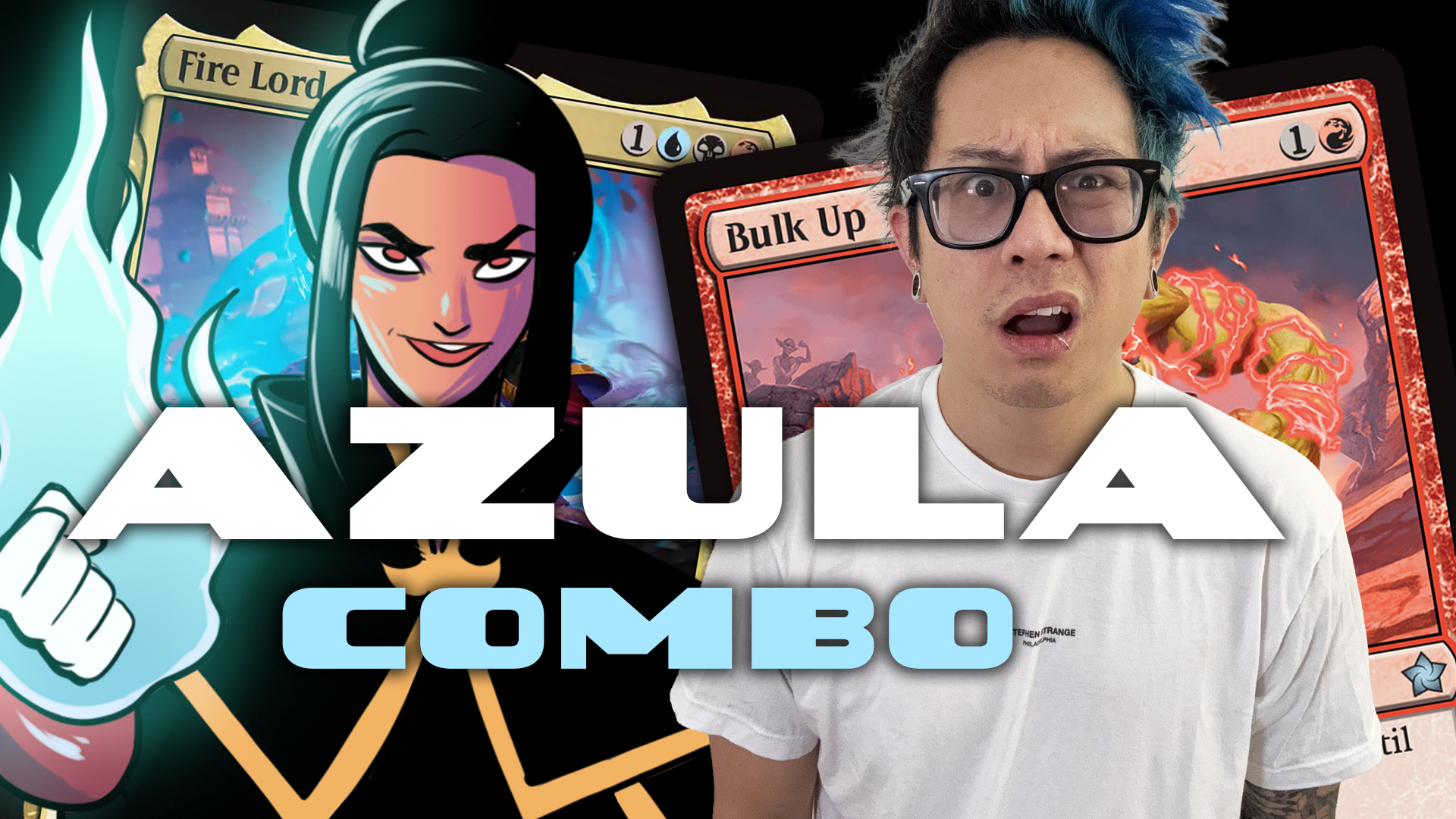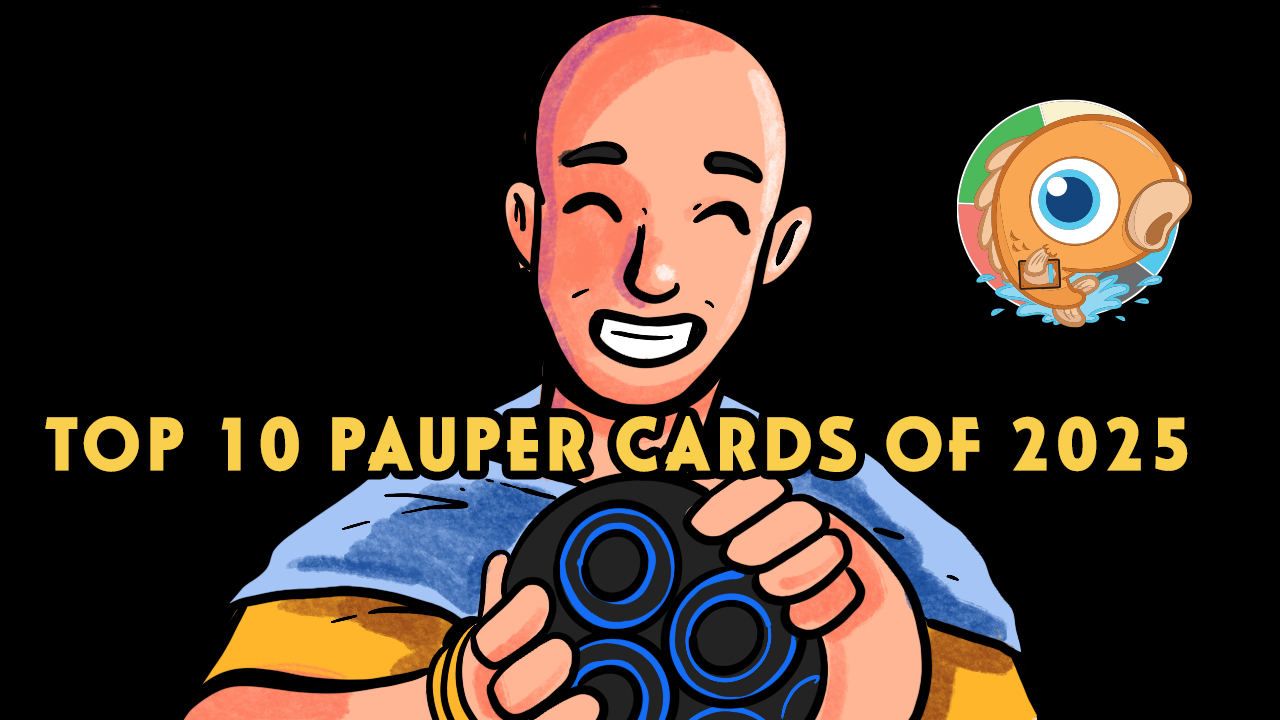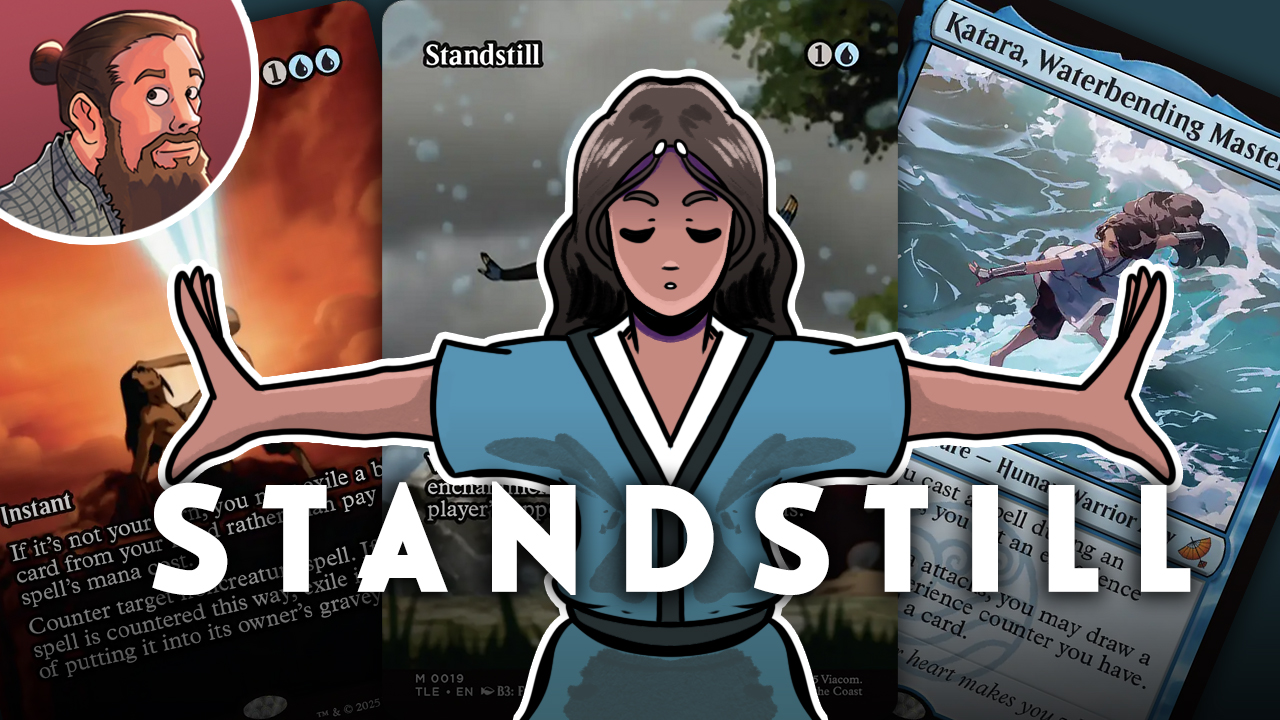Loreweaving: Random Facts You May Not Know About Innistrad
Hello, folks! My name is Cid Vale Ferreira, and it's an honor to debut this new column here at MTGGoldfish! From now on, you may recognize my articles by looking for Loreweaving, my column's name. As the title suggests, my focus will be the Vorthosian aspect of the game. I'm looking forward to share some visions on worldbuilding, flavor, art, and official storyline. Let me make clear that this is not a fanfic column, and I'm not offering unnofficial stories. My goal is to pick different sources and threads from the fragmented creative universe of Magic in order to connect them as I approach each theme. If you have suggestions, keep in mind that they are always welcome.
My first theme is Innistrad, a top-down gothic-inspired masterpiece. Mark Rosewater regards this set as his best design, and it's not uncommon to hear or read pro-players acclaiming it as the best limited environment ever. Luckily for us, we're going to revisit in the next two expansion sets: Shadows over Innistrad and Eldritch Moon.
You may have played cards from Innistrad, Dark Ascension, and Avacyn Restored. You may have watched their trailers and heard about the block's storyline, but there are so many scattered sources dealing with the plane's lore that it would take days to read and watch every narrative. Because of this, I selected some trivia for those who are already familiar with the plane but couldn't delve deep enough to discover all the details they contain. If you're a dedicated Vorthos, consider this piece a Innistrad recap. I hope you enjoy the ride!
Ten Random Innistrad Facts
- In order to achieve what art director Jeremy Jarvis considers their "ownability," Innistrad's monsters present unique differentials. Vampires have black scleras and were created by alchemy and demonic rituals using angelic blood, Skaab body parts are joined by copper plates inscribed with necromantic runes; their bodies also carry flammable oil and a bit of angel's blood ... but how could we recognize the plane's Werewolves? The answer lies in their almost gorilla-like proportions. Steve Prescott points out that instead "of sleek and super-muscles all over, these werewolves have smaller heads, elongated arms, tiny waists and hind legs, and smaller thumbs higher up on the wrist than a human hand." So, in case you're not sure if a Werewolf illustration depicts a creature from Innistrad, just check if their arms are longer than their legs.

Female werewolf concept by Steve Prescott
- Some great ideas were sadly lost during the block's development. To point out an example, Elbrus, the Binding Blade was originally conceived by Eric Deschamps as one of Withengar's fingers, but the creature was later developed as a 13/13 gargantuan Demon expected to be "as large as a building", so the initial idea had to be aborted.
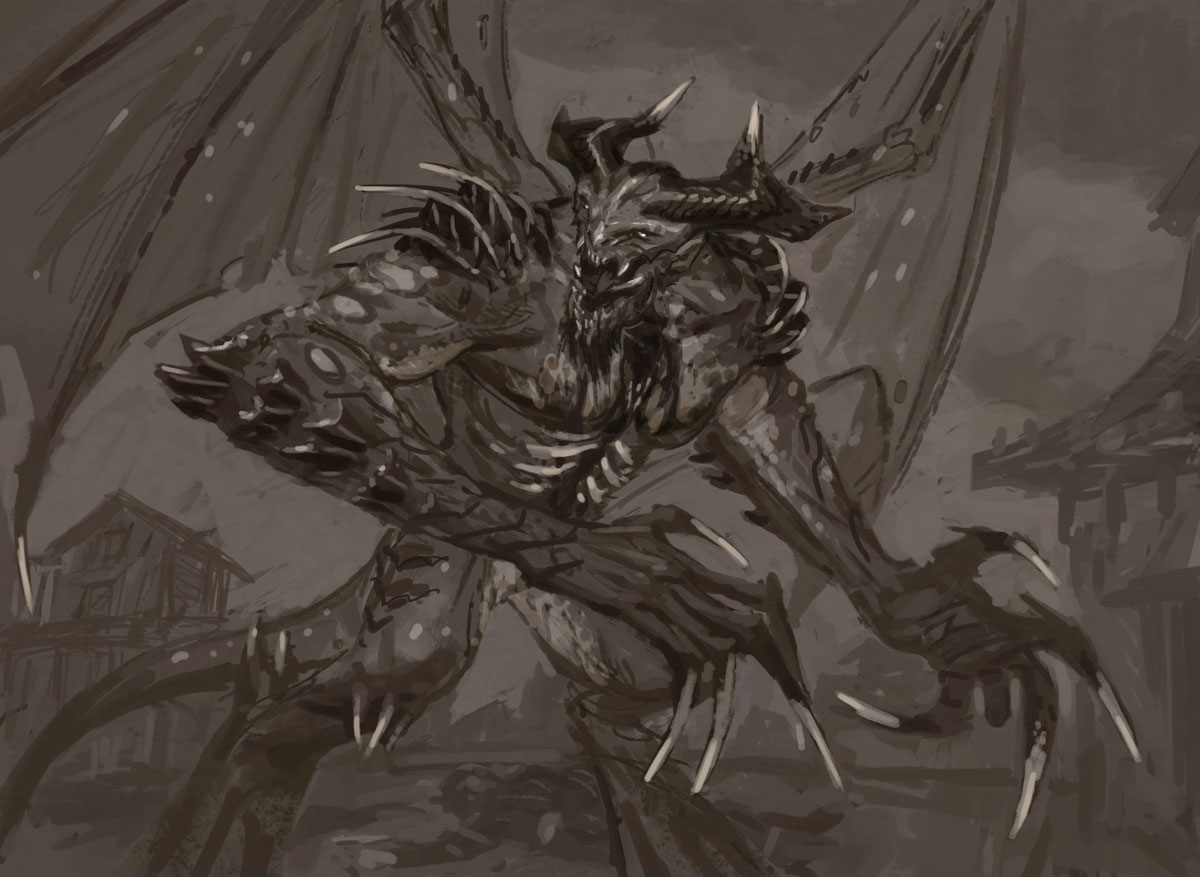
Withengar missing a finger, concept by Eric Deschamps
- It's almost impossible to look at Creepy Doll without thinking of Child's Play (1988), but this card's origin is a bit less obvious than it seems. Mark Rosewater is a big fan of New York's composer Jonathan Coulton, and he incited the team to come up with a top-down design based on the composer's "Creepy Doll" (click to download). In fact, Jenna Helland stated that the designers had this song played to them twice before the card was designed, making it a rare case of a card inspired by music.
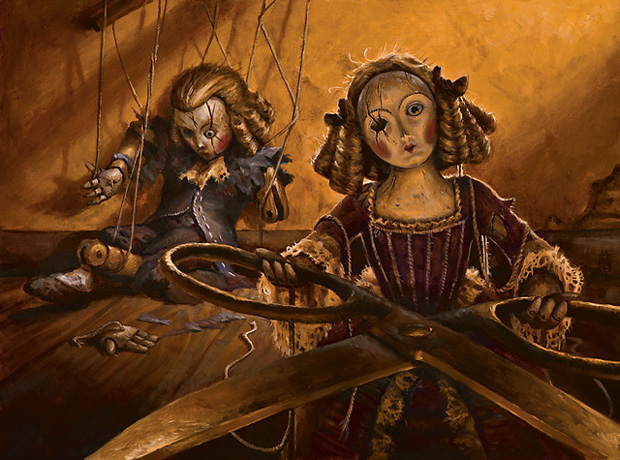
Creepy Doll by Matt Stewart
- Some of the most iconic gothic novels such as Frankenstein, Strange Case of Dr. Jekyll and Mr. Hyde, and Dracula are partially or integrally told through a compilation of personal letters and journal entries. To capture the subjectivity and emotional depth provided by this technique, the articles related to the gothic-inspired plane include epistolary narratives such as The Cursed Blade (the block's must-read masterpiece), Mikaeus, the Unhallowed (the exquisite letters of Gisa and Geralf about the siege of Thraben), and The Lunarch's Journal (the reactions of Lunarch Dovid to the discovery of Avacyn's creation by Sorin).
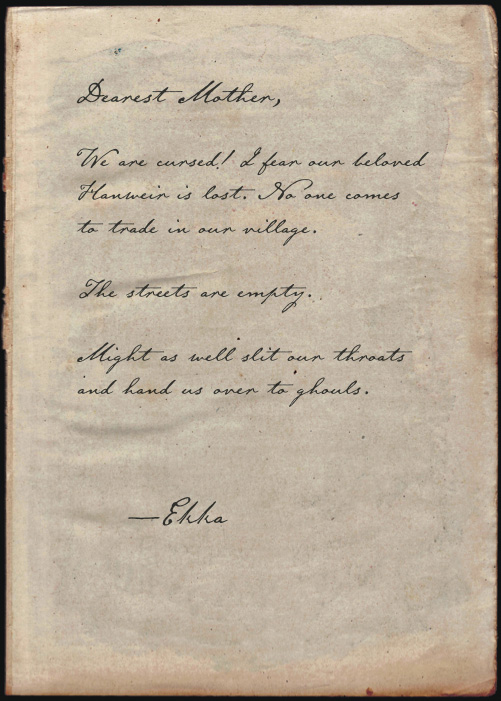
Except from The Cursed Blade
- Kessig's population needs to be creative to deal with lycanthropy. Some of the cursed ones sought the priests' blessings and hoped for a cure even before the Cursemute, others infiltrated demonic cults and used their deadly form in suicide attacks to try to redeem themselves, while other adapted crypts with reinforced iron bars to imprison themselves before their transformation. Some of the most gruesome procedures, however, came from Humans themselves, such as the measures to identify false silver. Some villages' gates would only allow passers bearing silver ornaments. To make sure the metal wasn't fake, they would touch encaged Werewolves with it, allowing the passage only if the captive's flesh burned with contact. Shockingly, in order to use less food and smaller cages, cursed children would often be employed in this task.
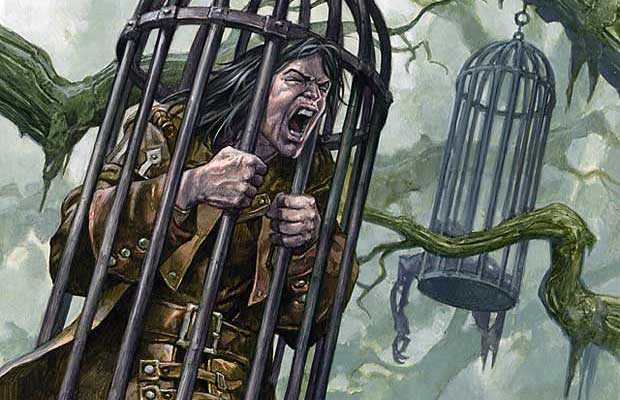
Wolfbitten Captive by Zoltan Boros
- Avacyn Restored lacked the double-faced cards of its predecessors, but the set's prerelease surprised players with something unique. Six thousand game stores received a "Helvault box" containing spindown life counters, oversized cards of the set's five legendary creatures, and a double-faced Angel / Demon token. Thirty of these stores, however, received premium boxes, making the Angel / Demon Token the first double-faced premium token (Marit Lage was the first "regular" foil token).
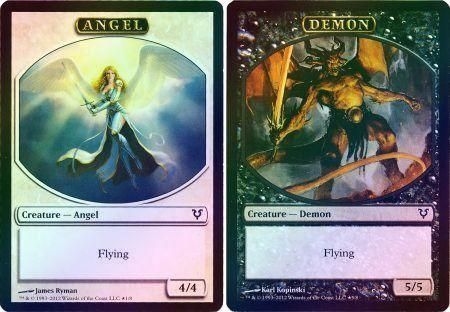
Foil double-faced Angel/Demon token
- Dack Fayden is considered the "Multiverse's greatest thief" because his two innate abilities allow him to absorb both the magical properties of artifacts and some of its previous owners' memories. This is how he learned that the Ancient Fang he stole from the Rakdos Cult belonged to Sifa Grent, the planeswalker that slaughtered the entire population of his hometown, including his family and lover. Dack's hatred for her took him to Innistrad, where he discovered the Ancient Fang's gigantic potential: by shedding a few drops of blood, its bearer unleashes a Vampire-controlling spell. Soon, Dack was approached by Sorin Markov, who implied not so subtly that any Vampire would kill to possess it, convincing Dack to exchange it for information concerning Sifa's whereabouts. Now, if his kin turns against him again, at least Sorin may have an extra tool to handle them. By the way, even without the fang, Dack can still replicate its spell (and not only this specific spell, but all the spells of every artifact he steals and spends some time with).
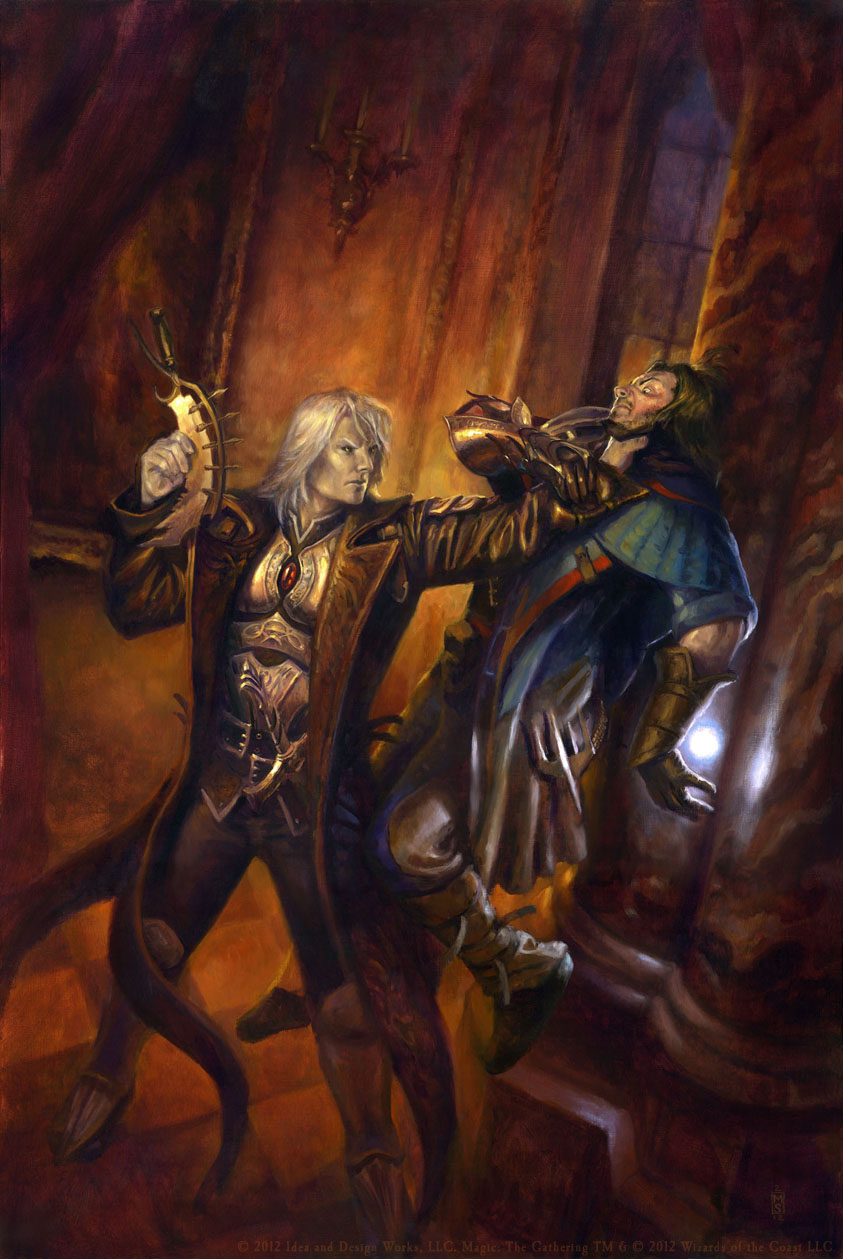
Art by Matt Stewart
- Before it was decided that each set would bring five cards depicting pivotal story moments, articles from the official Magic: The Gathering website provided additional artwork related to key moments such as Elspeth's shocking death at the hands of Heliod. Innistrad's plot got its reinforcement piece (with Thalia, Liliana, and the broken Helvault) in Checking in on the Planeswalkers, an article by Doug Beyer updating the status of every character represented in a planeswalker card.

Art by Todd Lockwood
- He hasn't appeared in a card, but besides Sorin and Tibalt there's a third known planeswalker native to Innistrad: Vronos. Adopted as a child after his (witch?) sister was captured and burned by Cathars, Vronos was raised by the Order of the Silver Heron and educated on the lore of Innistrad's monsters until he became an elite inquisitor. One night, he was awaken by a small Werewolf that attacked him in his sleep and disfigured his face. Severely wounded, he managed to reach his sword and kill this beast and a few others of its pack, but soon he realized they were all children when their corpses regained human form. Shocked and conflicted, he stopped reacting, letting the others charge upon him. Instead of dying, however, he awoke in a whole different world: Esper. There, he bargained with the Ethersworn Vedalken: their holy texts would be available to him in exchange for information gathered in each new plane he discovered. Soon, he was able to craft etherium implants to reconstruct his face and a mask made from the same æther-infused material. Back in Innistrad, he reported as a heretical penitent to Avacyn, who assigned him the most dangerous task of all: to find and bring Garruk to her before his curse turn him into a Demon. As we could see in Duels of the Planeswalkers 2015's trailer, his mission led him to an unfortunate fate.
Excerpt from the Duels of the Planeswalkers 2015 cutscenes
- A few days before Avacyn Restored's release, a card art depicting Garruk and Liliana (Triumph of Ferocity) was put in the spotlight for being reminiscent of sexual assault. A couple of years later, when it was included in Duels of the Planeswalkers 2015, the enchantment got a new alternate art with the cursed hunter surrounded by the corpses of Zombies. As Mark Rosewater stated, the "motives behind the illustration were pure," but out of context it could disturb a considerable amount of the audience.
.jpg/revision/latest?cb=20150519122851)
Duels of the Planeswalkers 2015's alternate art for Triumph of Ferocity by Karl Kopinski
Ten Bonus Drops
- According to Brady Dommermuth, Avacyn means "Moon Bird" in an ancient stage of a Germanic language (Dutch or Danish were his guesses).
- In Innistrad, Avacyn's creation is used as a reference to indicate the year in dates ("Ava. 714", "Ava. 179" and so on).
- Both Jenna Helland and Monty Ashley revealed the playtest names of some cards from the block's first set, and some of them are exquisite flavor gems: Bloodbath (Blasphemous Act), False Lycanthropy (Furor of the Bitten), Frankenstein Dragon (Skaab Ruinator), Haphazard Study (Desperate Ravings), Hunchback (Stitcher's Apprentice), Murderous Runaway (Reckless Waif), Necronomicon (Grimoire of the Dead), Open the Hellmouth (Into the Maw of Hell), Salvaged Guardian (Makeshift Mauler), Sample The Meat (Gnaw to the Bone), Slaughter Gator (Rotting Fensnake), The Mutilator (Grimgrin, Corpse-Born), Vampire's Den (Stensia Bloodhall), Zombie Butcher (Abattoir Ghoul), and Zoologic Mage (Delver of Secrets).
- The design team used the block's double faced creatures to offer mechanical translations to the main horror tropes ("the possessed innocent", "Jekyll & Hide", "The Fly," and so on), but a communication problem compromised the "angry mob" inspired transforming card. When development received the file, another card was created to represent the trope (Unruly Mob) and the original design gave space to a sentinel that alerts a militia (Thraben Sentry).
- Superstitions also played a role in Innistrad's design, specially triskaidekaphobia, the fear of the number 13. It became a recurrent subtheme, appearing in cards such as Army of the Damned, Blasphemous Act, Ludevic's Test Subject, Tragic Slip, and Tree of Redemption.
- Reflecting the release of hordes of Demons from the Helvault, Avacyn Restored has the highest number of them in Magic's history, thanks for the printing of Renegade Demon and Soulcage Fiend at Common rarity.
- You may have spotted mentions to "The Powerpuff Girls" in articles, podcasts, or panels. In case you didn't get it, it was a reference to Bruna, Light of Alabaster, Gisela, Blade of Goldnight, and Sigarda, Host of Herons, the leaders of the three avacynian Angel flights. They display a second color besides White, and these colors match the cartoon's girls outfits, so the nickname stuck.
- When Jeleva, Nephalia's Scourge was announced, Innistrad got its first blue Vampire (she's Grixis). Besides feasting on blood, she was presented as someone that craves to consume powerful Wizard minds. Regarded as innovative, this approach to psychic vampirism was already hinted by Avacyn Restored's Mental Agony, and it may represent fairly unexplored design space.
- The lack of double faced cards in Avacyn Restored demanded solutions. How would the set represent Werewolves? Creative came up with the Cursemute, a series of spells cast by the archangel of hope to minimize or nullify the curses on the whole plane. Those affected by lycanthropy were given the choice of merging their animal and human forms to become wolfirs, noble werewolves subordinated to Avacyn, and their cards didn't need transform anymore (Wolfir Avenger / Wolfir Silverheart). In Magic Origins, however, Call of the Full Moon gave us the first visual glimpse of traditional werewolves dwelling on Innistrad after Avacyn Restored — it's not clear if the scene took place before or after the Cursemute.
- Before Miracle was designed, R&D tested Forbidden, a mechanic aborted due to development problems. Mark Rosewater always affirmed he would like to try it again in the future and the mechanic's details remained secret ... until Aaron Forsythe revealed how it worked in a panel. Basically, you can't start a game with a card with Forbidden in your deck. They're all powerful cards representing the Helvault's magic, but you need additional effects that say you may pick them from your sideboard and shuffle them in your deck.
And before we leave, we can't forget this little teaser from the upcoming Shadows Over Innistrad:
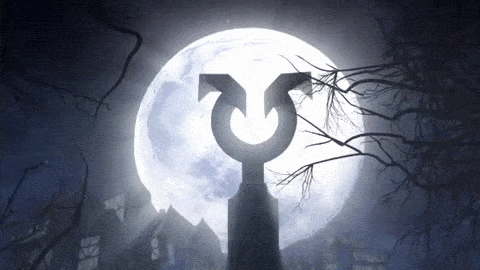
Excerpt from the Shadows over Innistrad teaser
Conclusion
Are you surprised by any of these? Would you add any other trivia to the list? Let me know your thoughts on this debut article by commenting below or through my social media accounts (Tumblr or Twitter). Until next time!




